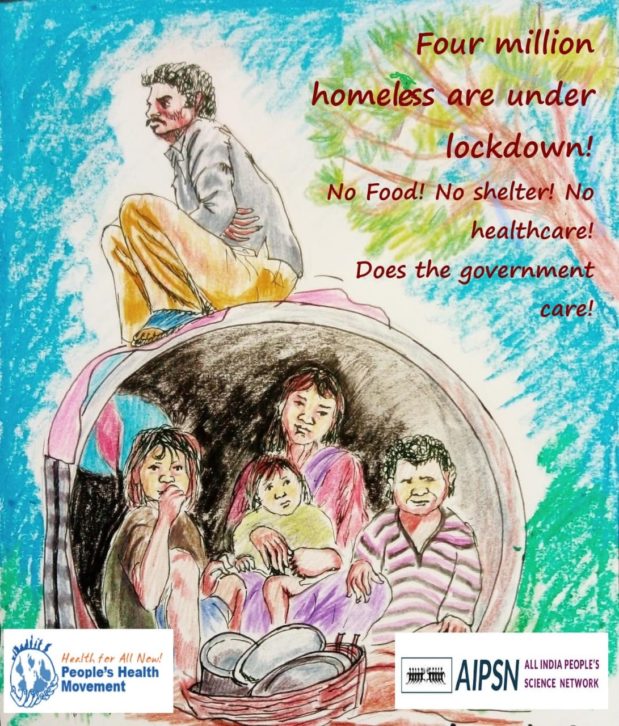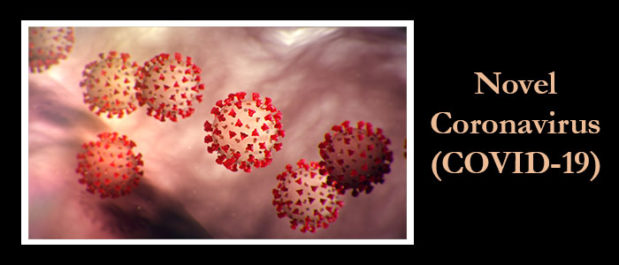English version -AIPSN-JSA-statement-on-lockdown_essential-services
Hindi version -AIPSN-JSA-statement-on-lockdown-of-essential services
Tamil version -AIPSNJSA-Statement-Lockdown-of-essential-services
AIPSN-JSA statement on lockdown_essential services
Essential Health Services cannot be suspended during the lockdown
Jan Swasthya Abhiyan and All India Peoples Science Network
Dated 27 March 2020
Jan Swasthya Abhiyan and All India Peoples Science Network express their deep concern over the poorly implemented lockdown, especially the closing of regular clinical services in public hospitals
The number of positive COVID-19 cases in India stand close to 640 with 17 deaths as on 26 March 2020 and it is increasing at a substantial rate everyday, with new cases being reported from every part of the country. This is a relatively high number given the limited numbers tested and the very limited scope of testing. There is therefore a high probability that the spread of the disease is being seriously underestimated.
As a way of combatting further spread, the Prime Minister announced complete lockdown across the country for the next 21 days starting midnight March 24. While the central government initially recommended lockdowns only in 75 districts from where positive COVID-19 cases or deaths were reported, the same has been extended to the whole country now. While lockdown may be a good strategy to ‘flattern the curve” and buy some time, there is a consensus among public health experts that it will not be effective if it is not accompanied by other public health measures like testing of suspected cases, isolation of cases and contacts, and tracing of possible contacts. There is little evidence to suggest that lockdowns alone can control this viral pandemic. We note that despite early lockdowns in Spain and France, these nations have seen an unprecedented increase in the number of cases and deaths. There are however, examples of countries like South Korea and Taiwan which have successfully controlled the outbreak by employing extensive testing, selective lockdown of “hot spots”, isolation and tracing, instead of imposing a complete lockdown. The Indian government seems to have gone into an overdrive by hastily implementing nationwide lockdown without giving much emphasis on either strengthening the health system or adopting public health measures. There is also not enough preparation for a surge in hospital cases and critical care requirements that need to be anticipated.
JSA and AIPSN also note that Western European nations that have undertaken lock downs have a high level of social security systems in places and these ameliorate the burden on the working people and the poor that the lockdown imposes. The vast majority of the population in India has no social security , and has to depend on government relief. While the central government has recently announced a Rs 1.7 lakh crore package and states have announced some relief measures, they are not adequate to address the huge humanitarian crisis that is unfolding due to the lockdown. There is need for more financial and food support measures to daily wage earners, migrant labourers and artisans who are losing their jobs and livelihoods. Moreover in many parts of the country, the lockdown is implemented forcefully, with people who are forced to come out, being beaten up by hostile and uninformed mobs or harassed by the police. Even grocery shops and vegetable vendors are being harassed though they are categorized as essential services. There are reports of medical professionals and health workers and healthcare support staff being beaten while on their way to work. The suspension of public transport without making any alternative arrangements has resulted in patients, including patients undergoing dialysis, chemotherapy etc. not being able to reach healthcare services. The impact of the lockdown is especially severe on the elderly and people with disability.
One of the most worrying dimensions of this lockdown is the adverse impact on existing healthcare services. We have received reports of closure of regular out-patient services in some of the leading tertiary care hospitals under both state and central governments, or planned reductions of on-going hospitalization care to accommodate an expected increase in the number of COVID-19 cases. It is not clear why hospitals should stop all elective or on-going and outpatient care before serious COVID-19 cases arrive. Nor is it clear as to why instead of organizing a separate isolated stream for suspected COVID-19 cases to protect the spread to other patients, denial of essential healthcare becomes the preferred strategy – even at primary healthcare level. We have reports of disruptions in HIV, TB and NCD control programs and child and maternal health servicesthat we would urgently draw the attention of authorities to. Moreover, we should not ignore the immense mental health crisis due to this sudden lockdown and panic that is being instilled in people. It will possibly lead to significant increase in depression, anxiety, suicides and domestic violence and affect health seeking by people which will also have long term consequences.
JSA and AIPSN urge the central and state governments to immediately review the lockdowns imposed across the country and take measures that are backed by science and evidence. There should be clarity on the criteria for lock-downs, what services would be locked down, how long such lock downs would be, and in what geographies this would be implemented. We caution that mathematical models that show lives saved due to early lockdowns have not factored in lives and the basic sustenance livelihoods that would be lost due to the cutback in access to essential services, especially healthcare services, under current lock-down conditions. We caution that on April 14, it is most likely that the incidence of new cases of COVID19 would be continuing, but this should not become the grounds for a mechanical continuation of a nation-wide lockdown, rather, evidence-based graded lockdowns in selected geographies should be considered as per requirement
Even as this report was ready for release we have reports of a huge “distress reverse migration” within the nation. Individuals and families stranded in cities without work, food, housing or security, are forced to trek back home to their distant villages, in the hot sun with no support of food, water, shade or rest, or hitching rides in crowded passing trucks at considerable expense, and subject to hostile action by authorities on the way intent only on imposing the lockdown. Those migrant, unorganized sector and daily wage workers who have been left behind in metros, cities and towns because of the lockdown with no transport available to their native villages/towns, find themselves without income, shelter, and even food, with state governments struggling to cope with the problem in overcrowded relief camps, again exposing these workers to infection. Even before the nationwide lockdown was imposed, anticipating this move and in view of the severe slowdown of economic activity due to industry closures, distancing or other measures, migrant labour and their families were fleeing metros and cities in huge numbers by long, overcrowded train or bus journeys, exposing themselves and others to infection, paying exorbitant amounts for last-mile journeys, and now face hostility, uncertain futures and potential spread of the Covid19 virus in their native villages and towns with already poor health care. This is a huge humanitarian crisis in the making.
With respect to lock-downs, we call on the government to consider the following measures urgently:
-
- Impose graded lockdowns only where and when necessary as supported by evidence. This should be implemented in a humane manner supportive of rather than hostile to citizens, along with aggressive mitigation measures.
- In areas where there are no reported cases of COVID-19, lockdowns are unnecessary and strengthening of surveillance and mitigation should be carried out. If there is a surge of clinically diagnosed or suspected cases of COVID-19, as could be made out from randomized testing, influenza surveillance or other data sources, the government should put this in the public domain so that both healthcare providers who manage such patients and the public could take greater precautions.
- Ensure the regular functioning of all routine and regular health services and health programs, irrespective of COVID-19 transmission. These are essential programs that also save millions of lives. Shutting these down would only reduce one cause of death by another. There are patients of HIV, TB, chronic non communicable diseases who must continue to recieve medication and care. We are also deeply concerned about denial of services to those related to maternity and neonatal and paediatric medical care and emergencies. To illustrate our concern we draw attention to the fact that in 2019 an estimated 30,000 women died in pregnancy, 1 million children died of preventable causes under the age of 5, and over 2 lakh persons succumbed to tuberculosis. If routine healthcare services are rolled back these numbers could rise sharply. We reiterate, ALL existing health care services should be actively safeguarded from being adversely affected or cutback during the period of lockdown or in any stage of combatting this pandemic. Orders to the effect that all existing healthcare services must continue should be issued as a priority and widely disseminated by the media.
- Hospitals must undertake special arrangements in the outpatient clinics so that all patients are screened for suspected COVID-19, and those that have suggestive symptoms are segregated into a separate flow, social distance within them maintained, and are examined by the medical team without compromising their own safety or that of the suspected case. Similarly isolation wards and ICUs for COVID-19 patients should also ensure segregation such that other patients and healthcare personnel do not get infected. Adequate personal protective equipment should be made available for health workers and other healthcare support staff.
- The blanket suspension of public transport must be reviewed and arrangements made for patients to reach health services and health workers and support staff such as sanitary workers, cleaners to reach their place of work.
- Support needs to be provided to people experiencing mental health issues through community and online support. Public messaging on this aspect is as important.
- There needs to be an immediate mapping of vulnerable households in each area by the local authorities and peripheral health workers (Panchayats, village officers, ward councillors, involvement of local SHGs, ASHAs in this etc). These would include for example elderly living alone, single women led households, households with a sick family member, households with young children etc. etc. These vulnerable households should specially be identified and provided social support in terms of availability of essential supplies, transport for essential medical needs etc.
- Local authorities must be empowered to use existing supply chains like PDS to help these vulnerable households and also others in their area to ensure essential supplies. The proposal to deliver essential goods through E-Commerce assumes everyone can avail this and the onus shifts to the individual.
- Immediately reach out to migrant families on the road and deploy buses and trains with medical and food relief to get the stranded families safely home.
- The announced economic and food security package should be expanded by the central and state governments to minimise the economic hardships to poor and disadvantaged groups due to the lockdowns.
For further information, please contact:
- Sundararaman – 9987438253
- Raghunandan – 9810098621
Sulakshana Nandi – 9406090595
Sarojini N. – 9818664634

